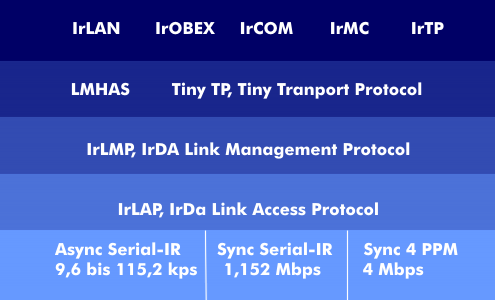infrared LAN (IrDA) (IR-LAN)
Infrared light systems use light ranges with wavelengths between 700 nm and 1,000 nm for transmission. These wavelengths are not visible to the human eye, but are perceived as thermal radiation above a certain minimum energy. Infrared light is generated with infrared LEDs and can be modulated at data rates of several 100 Mbit/s. Indata transmission, transmission rates of 100 kbit/s up to 2.3 Gbit/s can be achieved.
Infrared can be used to set up wireless LANs that can bridge 2,000 m with a point-to-point connection using lasers. However, a line-of-sight( LOS) connection is a prerequisite, since infrared cannot penetrate solid bodies. The transmission rate for such a connection is 10 Mbit/s. In addition to direct point-to-point transmission, there is the possibility of directional transmission in offices or production halls and the non-directional, diffuse IR connection. With the directional transmission, distances of up to 50 m can be bridged, with data rates of 10 Mbit/s, with the diffuse technique only short distances of less than 10 m with data rates of up to 16 Mbit/s. These techniques are used in Fast Infrared( FIR) and Very Fast Infrared( VFIR).
With infrared LANs, there is little interference between neighboring systems and no special frequency spectrum is required.
The protocols of infrared LANs are defined in IrDA, the Infrared Data Link Standard in version V.1.0. According to this, the half-duplexSIR protocol, Serial Infrared Physical Layer Link, is specified in the physical layer, the IrDA Link Access Protocol( IrLAP) in the link layer and the IrDA Link Management Protocol( IrLMP) for the transport layer.

